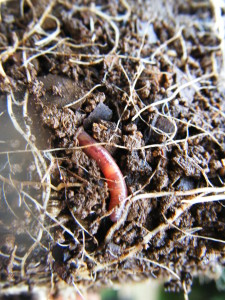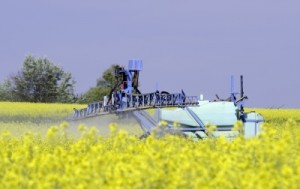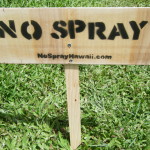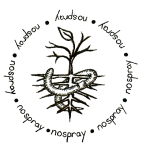The 6 Parts of Soil Explained
Oxygen
Six Parts of Soil
1. Minerals
2. Oxygen
3. Water
4. Organic Matter
5. Life Above
6. Life Below
=================================================================
Oxygen
Initially when we think of oxygen, we think of air. The stuff we breath. So how does that pertain to the soil? Like us, many different types of organisms and animals below the soil require oxygen in order to live. Thes e include aerobic bacteria, earthworms, insects, nematodes and even fungi.
e include aerobic bacteria, earthworms, insects, nematodes and even fungi.
In agriculture we see can see oxygen in the soil by looking at the spacing between the soil particles. Take a look at this picture, do you see all the holes in between the the brown soil? This is all areas where we would find oxygen.
Compost, earthworms and soil life all help create pathways, tunnels and areas for oxygen. The earthworm pictured not only provides space for oxygen but their burrows are large enough for roots to grow through. The deeper the organic matter goes down into the soil, the deeper earthworms will go to consume it, the deeper your plants roots will be able to “tap”. The more roots your plants have the more they are able to take up surrounding nutrients as well as be able to provide the support that is needed in the event of heavy winds.
Soil Compaction
Soil compaction can be thought of the depletion of oxygen from the soil. There are numerous ways soil becomes compacted. Humans cause compaction all the time as we walk through nature. Every step we can see the ground “sinks”. Other animals cause compaction as well like pigs, oxen, cows, goats, deer and even dogs. Depending on the weight of the animal determines the amount of compaction. Two cows will cause a lot less overall soil compaction than a herd of a 1,000 in the same space. It’s all about the weight.
On a small scale, compaction is fine. It is like pruning a tree. It sparks life. A tree pruned will begin to grow leaves within days. This small detrimental act sparks the wanting to grow and survive. Same with the soil. If the soil is healthy, small scale compaction sparks the life below to quickly burrow and tunnel through the “dead area”. This will start to increase oxygen levels. While burrowing through they will consume the dead and decaying life and roots that was killed by the compaction leaving nutrients throughout the compacted area in the form of various manures.
Tractors, tillers, and heavy machinery all contribute to large scale s oil compaction. This is like cutting down the whole tree at its base. We can not expect it to thrive within days. It takes months sometimes years to recover, same with the soil. When oxygen is depleted out of the soil on a large scale, life begins to die. When the life below the soil begins to die, so does the natural ecosystem. This ecosystem is responsible for recycling, storing and delivering nutrients to plants in forms that they can easily take up.
oil compaction. This is like cutting down the whole tree at its base. We can not expect it to thrive within days. It takes months sometimes years to recover, same with the soil. When oxygen is depleted out of the soil on a large scale, life begins to die. When the life below the soil begins to die, so does the natural ecosystem. This ecosystem is responsible for recycling, storing and delivering nutrients to plants in forms that they can easily take up.
This large scale soil eco-system collapse in our farmland is why we now are dependent on synthetic fertilizers and pesticides. These chemicals are merely replacing the natural life that was killed by heavy machinery. It can take three to five years (sometimes over 10 years) depending on how much compaction and nutrient loss actually happened over time.
Increase Oxygen Levels
This is the fun part. Increasing oxygen levels is increasing your soil microbe life all together. Heavy machinery should stay out of areas used to grow food. The moment a machine comes in, your back at square one. Your back to waiting the five years. This is due in part of past agriculture practices as well as the fact that life needs time to recover.
Old farmers, companies and even the government want you to use heavy machinery on your land. They encourage it. If you do it, then everything stays the same. Old farmers want you to use them so they don’t feel bad about using them in the past. Companies want you to use them so they make money. Governments want you to use them, so they to don’t have to change. Change is expensive for the government. Change has to be documented. Documents cost money.
Easy Ways to Increase Oxygen Levels
Responsible for naturally recycling decaying organic matter back into a form that plants can utilize as nutrients. These guys need oxygen to survive. They include IMO’s – Indigenous Micro-Organisms, bacteria, fungus, nematodes, protozoa just to name a few. As you add them in the form of compost and mulch you are naturally aerating the soil! To learn more about microbes and exactly what they do, where they live and how they supply nutrients that they recycled from decaying matter to plants in the forms they can take up CLICK HERE.
The most underutilized creature on the planet. Pound per pound these guys can supply the most nutrient rich manure than any other animal on this planet. They naturally burrow around the soil creating pockets for air. Roots can grow through their burrow utilizing the oxygen and castings. To learn more about earthworms and what they can do for your soil CLICK HERE.
Compost is a form of decomposed organic matter that has been given the time to be covered with microbes. Compost is light, fluffy, full of air and lots of spaces for homes to microbes.
For the Complete Reference List CLICK HERE
============================================================
About the Author:
 Laura Rieber holds a BS in Agriculture with a focus on sustainability from the University of Hawaii, several certificates in agriculture business development, food safety and is a master gardener. The moment she realized the corporate lies that feed the world was the moment she was inspired to write about the truth about natural agriculture. She co-created No Spray Hawaii with her partner, Jesse Fujimoto to help others gain awareness. She teaches natural agriculture principles on the Big Island of Hawaii. CONTACT
Laura Rieber holds a BS in Agriculture with a focus on sustainability from the University of Hawaii, several certificates in agriculture business development, food safety and is a master gardener. The moment she realized the corporate lies that feed the world was the moment she was inspired to write about the truth about natural agriculture. She co-created No Spray Hawaii with her partner, Jesse Fujimoto to help others gain awareness. She teaches natural agriculture principles on the Big Island of Hawaii. CONTACT
==========================================================
No Spray
Find another way!


